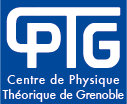Orateur
Dr
Giovanni FEVERATI
(Laboratoire d'Annecy de physique théorique, CNRS et Université de Savoie)
Description
Living organisms are made of nucleotides (DNA and RNA), lipids and proteins.
All biological activities consist in interactions between those different
entities. Identifying and rationalizing the interaction modes between
partners is therefore crucial for investigating any biological problem.
The interactions are encoded by patterns that are not easily inferred due to
the large number of possible combinations. We focus on interactions between
chains, or subunits, in oligomeric proteins, frequently encountered biomolecules
in cells.
Our approach is based on a symmetrization process that finds the
strongest interface interactions and describe them by graphs (interaction
networks). The graph topology contains important information on the
interface geometry and on the involvement of each amino acid.
The interface geometry is a key feature as it shapes most
of the physico-chemical aspects of the interface itself.
Thus, we need to manage it and and primarily investigate within each geometry
class.
Large dataset statistics have allowed us to extract aspects of
the graph topology in the interface geometry given by an intermolecular beta sheet.
Interesting specific features have been revealed:
the presence of two typical subgraphs, a peculiar organization of the graph,
a different use of amino acids in the two subgraphs, and so on.
A careful geometrical study of the symmetrization has shown that the
interface interactions are ranked in levels and can be organized in clusters,
according to the local topology and geometry. A hierarchy of graphs emerges.

